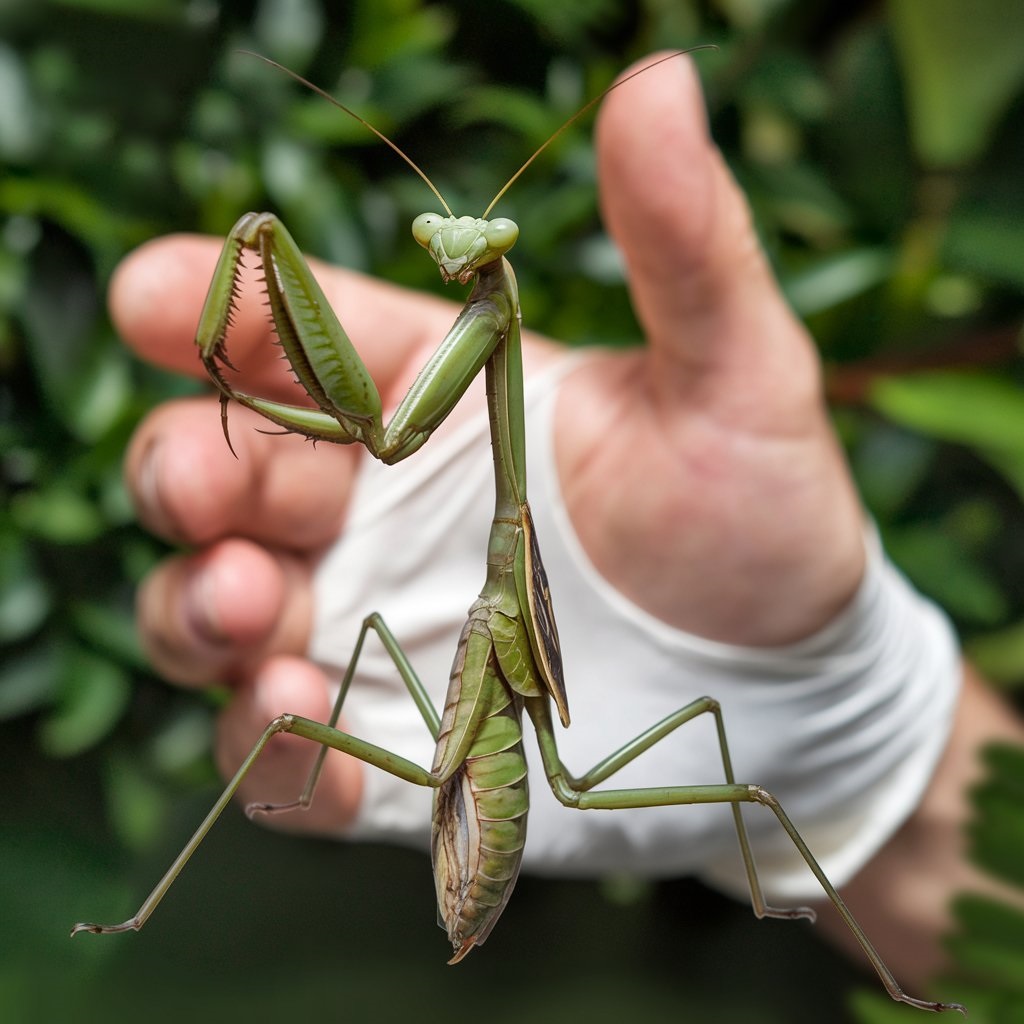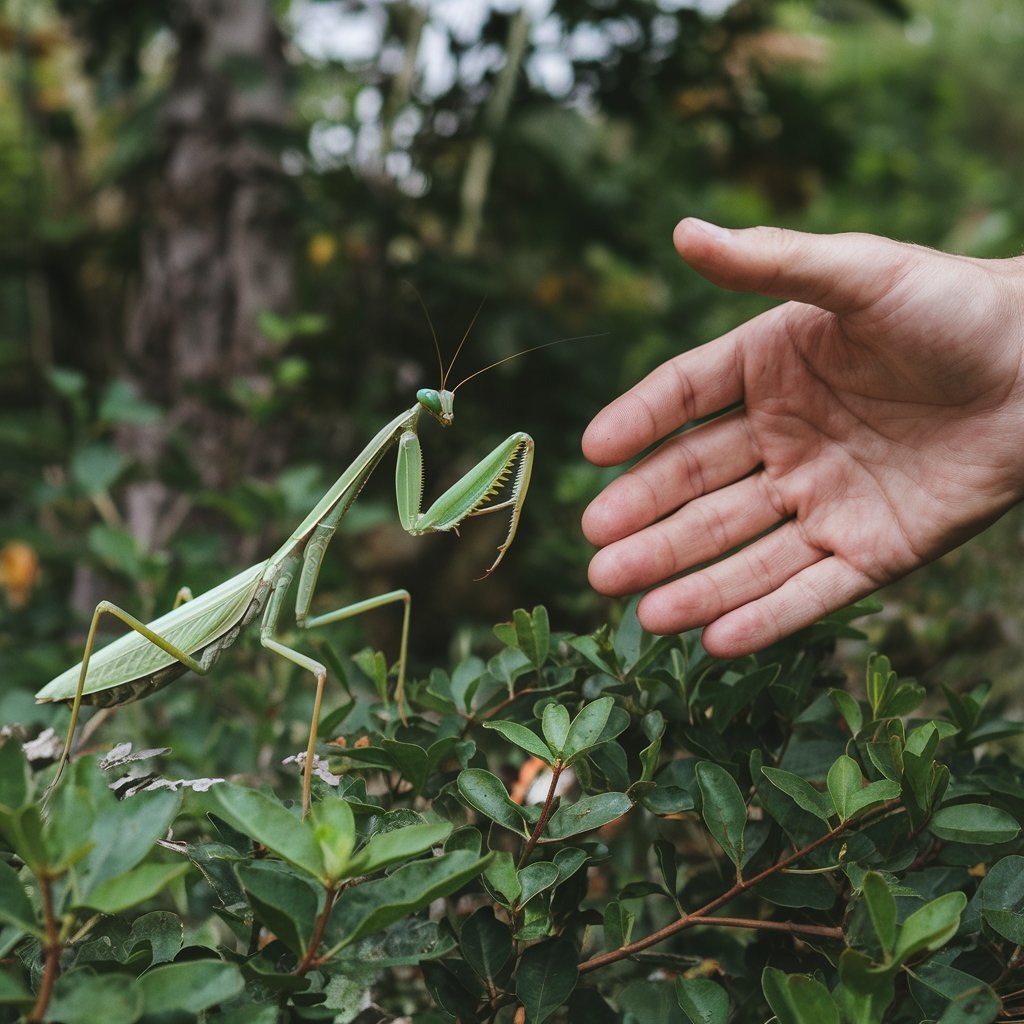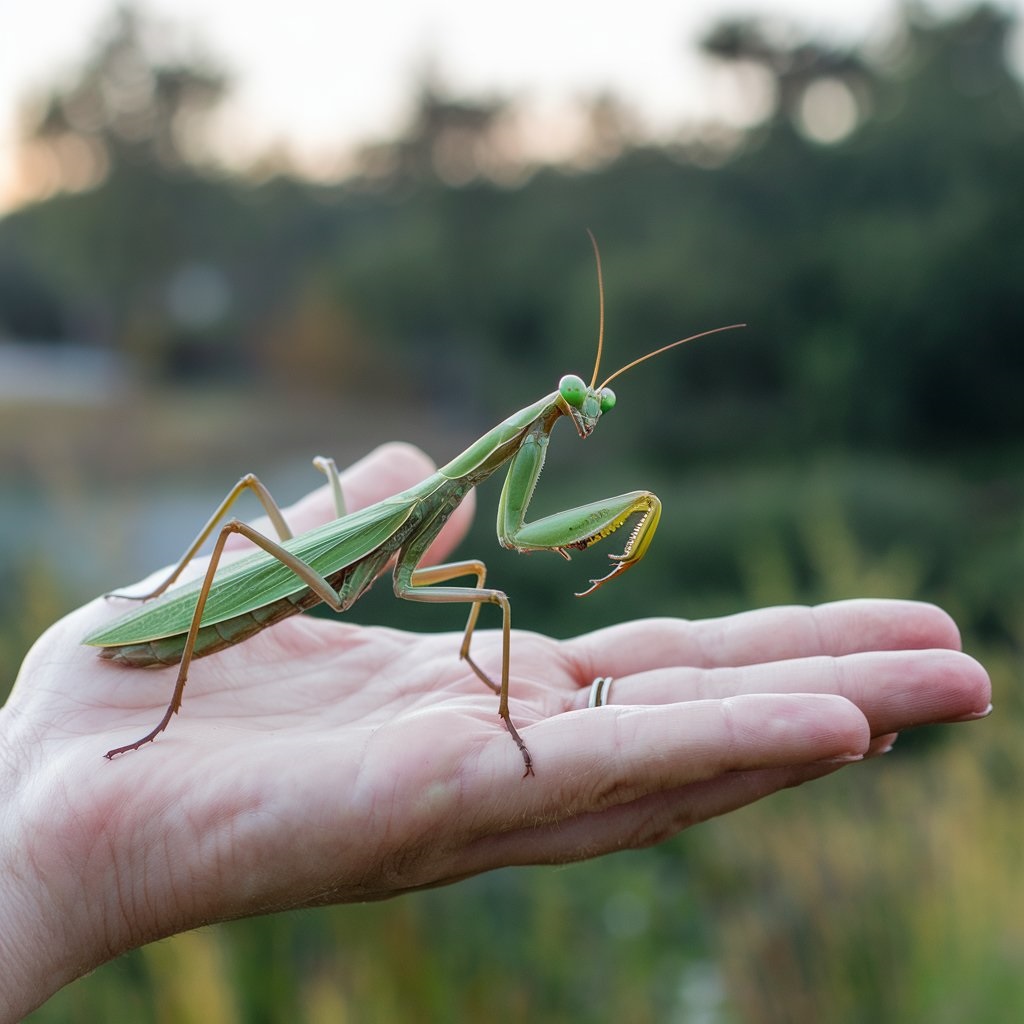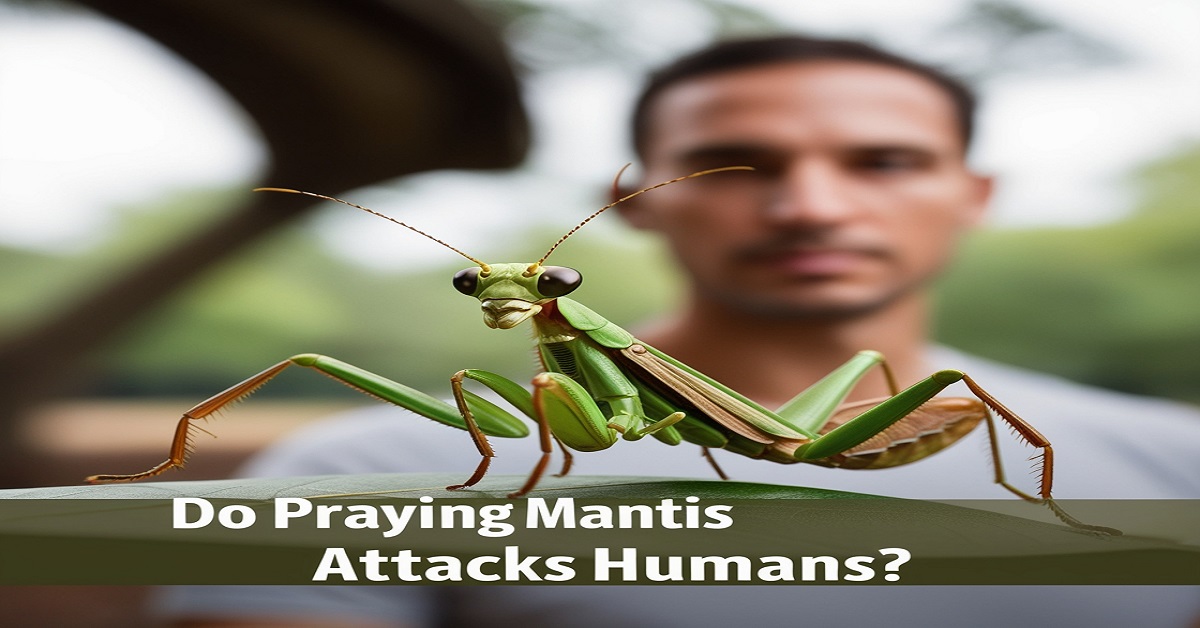When you think of the praying mantis, what comes to mind? Perhaps it’s their unique posture, their triangular heads with bulging eyes, or their camouflage skills that make them blend into plants and leaves. But when it comes to their interaction with humans, one question often pops up: Do praying mantis attack humans?
In this article, we’ll explore the fascinating world of praying mantises, their behavior, and whether they are a threat to humans or just misunderstood creatures in the insect world.
Facts and Figures: Praying Mantises vs. Humans
| Category | Details |
|---|---|
| Scientific Order | Mantodea |
| Number of Species | Over 2,400 globally |
| Primary Habitat | Tropical, subtropical, and temperate regions |
| Common Prey | Aphids, flies, grasshoppers, moths, bees, butterflies, frogs, lizards, and small birds |
| Camouflage Colors | Green, brown, pink (depending on the species and environment) |
| Vision | Wide field of view with triangular heads and multi-faceted eyes |
| Head Rotation | Nearly 180 degrees |
| Predatory Style | Sit-and-wait ambush predator |
| Defensive Posture | Raises forelegs, spreads wings (in some species), and displays threatening behavior |
| Bite Frequency | Rare, typically occurs when the mantis feels threatened or mishandled |
| Venom | None—bites are non-venomous and generally harmless |
| Ecological Role | Natural pest control by hunting harmful insects |
| Threat Level to Humans | Minimal—non-aggressive and non-threatening unless provoked |
| Bite Effects | Minor pain, redness, or irritation; no long-term harm |
| Allergic Reactions | Extremely rare |
| Key Defensive Mechanisms | Camouflage, flight, defensive posturing |
| Environmental Benefits | Reduces need for chemical pesticides, promotes biodiversity, and balances pest populations |
| Human Interaction Tips | Observe from a distance, handle gently if needed, and avoid startling or confining them |
What Are Praying Mantises?
Praying mantises are predatory insects found in diverse environments ranging from gardens and forests to deserts and urban areas. Known for their distinctive elongated bodies and triangular heads, these insects belong to the order Mantodea. With more than 2,400 species globally, they are present in tropical, subtropical, and temperate regions. Their ability to blend into their surroundings, using natural camouflage in colors like green, brown, or even pink, helps them remain unseen by both their prey and potential predators.

Physical Characteristics of Praying Mantises
- Triangular heads with bulging, multi-faceted eyes that allow for excellent vision.
- Grasping forelegs equipped with spines to seize and hold prey.
- Long, slender bodies that are perfectly adapted for ambush hunting.
- Ability to rotate their heads 180 degrees, providing a wide field of view.
This combination of features makes the praying mantis a master ambush predator, ready to strike at a moment’s notice.
Do Praying Mantises Attack Humans?
The idea of a praying mantis attacking humans is a common misconception, largely stemming from their predatory behavior and eerie appearance. However, praying mantises are non-aggressive toward humans. They don’t seek out humans as prey, and their behavior is typically defensive rather than offensive. Let’s dive into what might trigger a mantis to interact with humans.
Why Might a Praying Mantis Seem Aggressive?
A praying mantis will usually react defensively if it feels threatened. It may display a threatening posture by raising its forelegs or even attempting to bite if handled improperly. However, these bites are rare and tend to occur when the mantis feels cornered or frightened. Despite their formidable forelegs, which they use to capture prey such as aphids, flies, and even grasshoppers, mantises are not interested in attacking humans.
Understanding Their Behavior
To truly appreciate the praying mantis behavior, it’s important to understand their hunting and defensive strategies.
Predatory Behavior
Praying mantises are sit-and-wait predators, meaning they typically stay motionless, blending into their environment, until prey comes into range. They use their grasping forelegs to snatch up insects like moths, bees, and butterflies, but larger prey such as frogs, lizards, and birds are also occasional targets. Once they have captured their prey, they will eat it alive.
Camouflage and Defense
Praying mantises rely heavily on camouflage to evade predators like spiders and birds. By blending in with their environment, they avoid detection and keep safe from animals that might try to make a meal out of them. If they are disturbed or handled, mantises will often raise their forelegs in a defensive posture, warning potential threats to back off.
Head Rotation
An interesting feature of the praying mantis is its ability to rotate its head almost 180 degrees. This provides an expansive field of vision, which is crucial for spotting both predators and prey. This head movement can give the illusion that a mantis is “staring down” a human or other animal, adding to their somewhat intimidating presence.

When Can They Bite?
While the praying mantis bite is often feared, it’s important to understand that they are not venomous and their bites are usually not harmful. The biting behavior generally occurs in the following situations:
- Handling: If a praying mantis feels trapped or manipulated in an unnatural way, it may bite as a defensive measure.
- Perceived Threat: If it feels threatened by quick or erratic movements near it, a mantis might react defensively.
- Mistaken Identity: If a mantis feels cornered or stressed, it might misinterpret human interaction as a threat.
A praying mantis bite typically causes minor pain, but it is not a cause for alarm. The bite might leave a slight mark or redness, similar to a mosquito bite.
Are Praying Mantis Bites Dangerous?
For most people, a praying mantis bite isn’t dangerous. These insects do not possess venom, so their bites don’t cause severe health issues. However, there are a few things to keep in mind:
- Minor Irritation: The bite can cause temporary pain, redness, or swelling, much like a mild insect bite.
- Allergic Reactions: Though rare, some people may experience an allergic reaction, resulting in more severe swelling or irritation.
- No Long-Term Harm: In most cases, a praying mantis bite will not lead to long-term damage. Simply clean the area with soap and water to avoid infection.
Myths vs. Reality
Many praying mantis myths have been perpetuated over time. Let’s debunk some of the most common misconceptions.
Myth 1: Praying mantises attack anyone they see.
Reality: Praying mantises are not naturally aggressive toward humans. They are primarily interested in catching prey such as flies and grasshoppers, and will only bite in rare defensive situations.
Myth 2: Praying mantis bites are venomous.
Reality: Praying mantis bites are non-venomous and generally harmless to humans. The pain from a bite is short-lived and comparable to a minor insect sting.
Myth 3: Praying mantises are dangerous to pets and children.
Reality: Praying mantises do not actively seek out pets or children to harm. They are not aggressive and will typically avoid contact unless threatened.
Cases of Bites and Misconceptions
While rare, there have been some documented cases of praying mantis bites. These incidents usually happen when the mantis feels physically threatened or trapped. It’s important to note that mantises generally prefer to avoid confrontation and will use their defensive behaviors—such as raising their forelegs or attempting to fly away—before resorting to biting.

Case Study: The “Attack” Myth
A viral incident involved a viral video showing a person claiming to be “attacked” by a mantis. However, upon closer inspection, the mantis was simply trying to defend itself, not actively attack the person. This is a perfect example of how misconceptions about aggression can arise when observing the behavior of these fascinating insects.
Are Praying Mantises Dangerous?
In terms of human safety, praying mantises are harmless. They pose little to no risk to humans unless handled incorrectly. They are non-aggressive insects that primarily hunt smaller insects and small animals such as frogs and lizards. Their role in the environment is far more beneficial than harmful, as they help regulate pest populations.
The Ecological Role of Praying Mantises
Praying mantises play a vital role in natural pest control. By hunting insects like aphids, flies, and moths, they reduce the need for chemical pesticides in gardens and agricultural fields. In doing so, they contribute to the balance of ecosystems, promoting biodiversity and supporting the health of plants and other beneficial insects like bees and butterflies.
Benefits of Having Praying Mantises Around
Having praying mantises in your garden or home can be an asset. Here’s how they help:
- Natural Pest Control: Mantises eat a wide variety of pests that can damage plants and crops, including aphids, flies, and grasshoppers.
- Reduction of Pesticide Use: By relying on mantises to control pests, you reduce the need for harmful chemicals in your garden.
- Biodiversity: The presence of praying mantises contributes to the overall health of the ecosystem by controlling pest populations and allowing other species to thrive.
How to Safely Observe Praying Mantises
Praying mantises are a fascinating species to observe, but they should be handled with care. Here are some tips:
- Observe from a Distance: Mantises are best appreciated from afar. Keep your distance to avoid startling them.
- Gentle Handling: If you choose to handle a mantis, do so carefully by gently cupping it in your hands. Avoid grabbing it by the wings or legs.
- Respect Their Space: Let them move freely and avoid putting them in confined spaces unless you plan to observe them in a controlled environment.

FAQs
Can a praying mantis hurt a human?
Praying mantises are not harmful to humans; while they might bite if provoked, it’s usually painless and poses no threat.
Can praying mantises be aggressive?
Though generally calm, mantises can display aggression, especially females, depending on their age and environment.
Are praying mantises friendly?
Praying mantises are harmless and can be handled safely, making them an interesting choice for supervised interaction with kids.
Can you keep a praying mantis as a pet?
Yes, praying mantises can be kept as pets and are fascinating to observe with minimal care and basic equipment.
Is a praying mantis considered good luck?
Mantises are often seen as symbols of good luck, prayer, and wisdom in various cultures worldwide.
Is it bad to touch a praying mantis?
Touching a mantis is safe, as they are neither venomous nor harmful, despite their intimidating appearance.
What are the natural enemies of praying mantises?
Predators like frogs, lizards, birds, spiders, and hornets pose significant threats to praying mantises.
Final Verdict
To answer the question, Do praying mantis attack humans?—no, they do not. Praying mantises are non-aggressive insects that are simply misunderstood. They might bite if they feel threatened, but this is rare and typically not dangerous. Mantises are beneficial creatures that play a crucial role in natural pest control and the balance of ecosystems. By understanding their behavior and respecting their space, you can safely observe these remarkable insects without fear.
So, next time you spot a praying mantis in your garden or backyard, take a moment to appreciate its role in the ecosystem and the beauty it brings to the world around us.
Read more knowledgeable blogs on Flowy Magazine

James Clair is a passionate writer and researcher with a deep fascination for animal behavior and its intricate connection to human life. With a background in [relevant field of study, e.g., zoology, psychology, ethology], James has spent years studying the natural world, focusing on how animals’ actions and instincts impact human emotions, behavior, and society.
His expertise in [specific topics or regions of focus, e.g., canine psychology, animal communication, wildlife conservation] has led to numerous published works and collaborations with renowned researchers and institutions. Through his work at Flawy Magazine, James aims to bridge the gap between scientific research and public understanding, offering insightful, accessible articles that explore the complex relationship between humans and animals.
When he’s not writing, James enjoys [personal hobbies or interests, e.g., hiking in nature, volunteering at animal shelters, photography] and is an advocate for [cause or charity related to animals or conservation]. His mission is to inspire readers to see animals not just as companions or creatures of the wild, but as beings whose behavior holds valuable lessons for us all.









